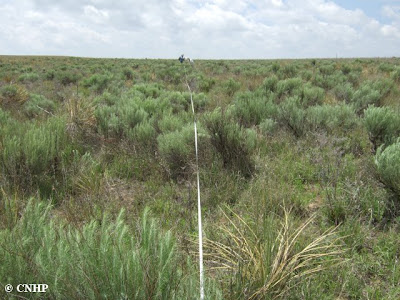Almost any size or shape of area (quadrat) could be used for measuring density, but results can vary with quadrats of different shapes and sizes. It is important to apply consistent boundary rules about whether a plant is in or out of the quadrat, especially for long narrow quadrats, which have more edge than square or round quadrats. Some options are:
- count only one out of every two plants that are on the boundary
- count all plants that touch the boundary, but only for two sides of the quadrat
- count plants that have more than 50% of their area in the quadrat
CNHP ecologist Karin Decker measures the density of sand sagebrush (Artemisia filifolia) in potential habitat for the lesser prairie chicken, using a 1 meter-long stick to find and count shrubs within 1 meter of the 50 m tape.
Example of low density sand sage (4 per 100 square meters).
Example of higher density sand sage (44 per 100 square meters).






No comments:
Post a Comment
Thanks for your comment!
Please note that all comments are moderated, so there may be a delay of some hours (especially over the weekend or at night Colorado time) before your comment shows up.